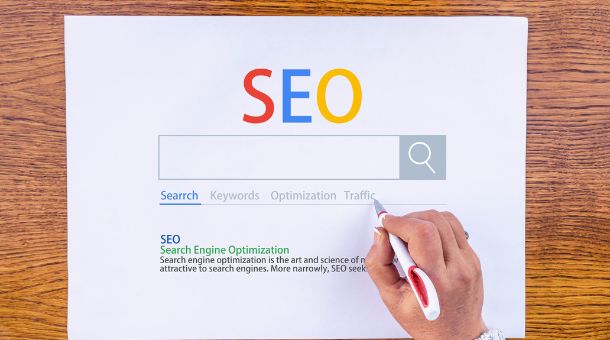In this article, we will discussed How to optimize your landing pages for search engines? Your marketing team has worked tirelessly to design amazing landing page content that can connect with your visitors and convert them into buyers.
However, none of your efforts are worth anything when no one can find it. Only a deep knowledge of SEO on landing pages will help you achieve this.
While nearly every digital marketer is aware of how crucial comprehensive SEO will be on blog posts and stand-alone web pages, landing pages often be left out in terms of SEO.
What is SEO?
SEO, which stands for Search Engine Optimization, is a method to make your site and landing pages appear more prominent (rank better) in the results that organically appear on the search engines.
How to optimize your landing pages for search engines?
Optimized landing pages to meet SEO guidelines will deliver more traffic to those who need your services. How? Search engines will be able to comprehend the function of your site and place it higher on the search result pages. A higher ranking results in more visitors.
Your visitors can find your site when they require it most. This enhances their experience, which leads to greater conversions.
Optimized landing page pages can boost Your page’s Page Quality Score. This can bring additional advantages such as less expensive and more efficient Google AdWords campaigns.
When to use SEO stactics for a landing page
SEO is an endurance race but not an event. It’s crucial to know the right time to implement SEO on your landing page and when you shouldn’t.
Optimizing your website’s pages will take time and will not yield results in a single day. The changes you make to your website require time for engines to understand. The results can take months to show.
If you’re conducting a short-term marketing campaign, Don’t spend your time on SEO.
It is important to establish your expectations for the longer term. Make sure you focus your attention and energy on landing pages you plan to keep for extended durations of time (over six months, or anticipate that it will become seasonal).
Top 7 steps to create SEO-friendly landing pages

1: Know your keywords
Before you begin optimizing your landing pages, you must know what keywords you want to focus on. Keywords are the use of single-word phrases (like “marketing”) as well as short phrases (like “email marketing”).
Drink a jolting beverage of your choice, and get your brain going. Which is the ideal word to describe the page I have created? Create a list of these phrases and do a bit of study.
Input the words you want to search into engines. What do they give you? Are there similar websites to the theme of your landing page? Consider their keywords and place them in the list. Perhaps you should reconsider your keyword if there aren’t any relevant websites.
Most likely, humanity blessed with an Internet connection has differing opinions on the meaning of your keywords. Also, did you receive any relevant suggestions from the internet search engines? Please include them in the list, too.
2: Publish your pages to your domain
When designing landing pages with the highest SEO methods in mind, selecting URLs is crucial.
Remember that search engines such as Google require to know the actual primary site inside that URL, not just some random auto-generated URL. So, always make sure you upload your landing pages to the domain you own.
It also provides more brand consistency and ensures that your customers know they are communicating directly with your company.
It lets your landing page use any authority in search engines that you’ve probably already created for your domain.
3: Create an SEO-friendly title
Titles are the most crucial element to consider regarding SEO on landing pages. Ensure that your title accurately describes the page’s contents without becoming too lengthy.
Search engines generally display only 60 characters in the title of SERP listings, So; you can make them count.
Of course, it is important to include keywords with the best examples used in the first place. Search engines concentrate more on the keywords closest to the left-hand side of your page title.
If you are using multiple keywords on your page, you can use vertical bars to show the words and phrases that go together
4:Tune-up your URL
Like a cherry on top makes a cake appear more appealing (and more delicious since we eat our food by looking at it), A landing page URL that contains keywords can attract search engines.
Make sure to include your keyword in the URL of your landing page. If you can – you don’t want to make it appear excessively long and cluttered because this is bad for the user experience, so be careful not to push it.
5: Craft a concise meta description
The meta description of your page meta description does not directly impact your SERP rank in the same way your URL or title will.
But it can help users of search engines decide whether they should go to your website or not, making it essential to SEO for landing pages.
The most important thing to make good Meta descriptions of landing page pages should be clear and concise, and you can get straight to the point in a short amount of time.
Use these to let people know exactly what they’ll see behind the hyperlink if they decide to select it. Otherwise, most people will disappear once they arrive on your page and hurt your SEO.
6: Words, words, words
Search engine robots are amazed by the ability to read, even if they can’t comprehend the meaning of a term… However, it changes. It doesn’t matter how well they grasp the meaning in the text or appear more like a Chinese Room argument. They require words to function.
Your primary focus when creating copy for your landing pages is convincing visitors to act. Remember that, but include text with the main keywords and any additional ones and other keywords.
If you have to, inflect them, and they will appear more professional. You can even cut sentences into single words and spread them across the text. If all else fails and you cannot incorporate your keyword, try using its synonym. It’s not the best solution, but it can at the very least provide bots with a hint of the subject on your page.
7: Don’t forget to optimize images.
It could be more challenging for Google and the rest of these search engines to comprehend and categorize the visual elements that appear on landing pages.
But you can make the process easier by optimizing the specifics associated with your images.
It is also important to remember that users tend to browse through the images tab in search results, and so optimizing your images will help SEO in a significant way.
Choose the name of your image’s file. Be careful, making sure to keep it brief, however descriptive. Make use of dashes to separate words.
It’s worth taking a few minutes to select the appropriate alt-text to use, too, as this is what appears on the image’s screen if it doesn’t load at all. (Screen-reading software can also use alt texts.)
The alt text is clear and concisely describes the image.
FAQ about How to optimize your landing pages for search engines
Should landing pages be optimized for SEO?
Pages optimized by SEO guidelines will deliver more visitors to those needing your services. How? Search engines will comprehend the function of your website and will rank higher in results from searches. An improved ranking means greater visitors.
What are keywords for SEO?
Keywords are concepts and topics that determine the subject matter of your blog posts. For SEO, it’s the phrases and words that users type into search engines.
They are sometimes referred to as “search queries.” If you combine everything on your website — all of the photos, videos, copies, and text, you’ll have a lot of content.
What are the key elements of on-page optimization?
Unique, valuable, current, professionally written, shared, and valuable information. The primary and most essential component of on-page SEO is, of course, your content.
- Title of page and Meta description.
- 100% SEO-friendly content.
- SEO-friendly design and hyperlinks.

